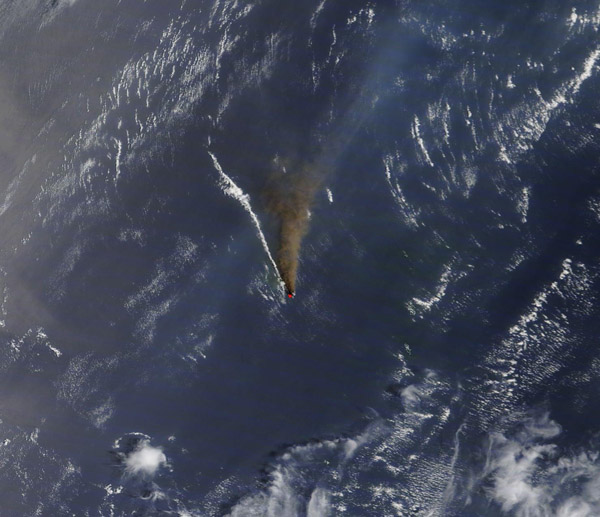Images
July 10, 2020 - Ash plume from Nishinoshima volcano
Tweet
A young volcanic island has been erupting in the western Pacific Ocean, producing spectacular explosions, lava flows, and, most recently, dramatic plumes of dark gray ash. After 40 years of dormancy, Japan’s Nishinoshima volcano erupted in 2013, rising the pyroclastic cone above sea level. Eruptive events through November 2015, then again in mid-2017 and July 2018, increased the size of the island before it became temporarily quiet. The Smithsonian Institution’s Global Volcanism Program reported that the next eruption of ash plumes, incandescent ejecta, and lava flows began in December 2019. Since mid-June 2020, the growth spurt has been particularly dramatic and vigorous.
The Moderate Resolution Imaging Spectroradiometer (MODIS) on board NASA’s Terra satellite acquired true-color image of the volcano on July 8, 2020. Located about 600 miles (1,000 km) south of Tokyo, Japan, the active eruption spewed a constant dense dark ash emission extending north to northwest across a large swath of the Pacific Ocean. A red hot spot marks the area where the thermal bands on the instrument detected high temperatures. This likely represent a fresh, hot lava flow.
The Japan Meteorological Agency (JMA) reported that at about 12:52 p.m. local time on July 8, an ash plume rose 19,356 feet (5,900 meters) above the summit of the pyroclastic cone. The highest ash plume off the volcano since 2013 was recorded on July 4. That plume rose 17,230 feet (8,300 miles) above the summit and drifted north. The warning bulletin from the JMA on that date reported that ballistic impacts of volcanic bombs were ejected as far as 2.5 km away from the crater (1.5 miles).
Image Facts
Satellite:
Terra
Date Acquired: 7/8/2020
Resolutions:
1km (59.6 KB), 500m (201.4 KB), 250m (582.1 KB)
Bands Used: 1,4,3
Image Credit:
MODIS Land Rapid Response Team, NASA GSFC
Tweet
A young volcanic island has been erupting in the western Pacific Ocean, producing spectacular explosions, lava flows, and, most recently, dramatic plumes of dark gray ash. After 40 years of dormancy, Japan’s Nishinoshima volcano erupted in 2013, rising the pyroclastic cone above sea level. Eruptive events through November 2015, then again in mid-2017 and July 2018, increased the size of the island before it became temporarily quiet. The Smithsonian Institution’s Global Volcanism Program reported that the next eruption of ash plumes, incandescent ejecta, and lava flows began in December 2019. Since mid-June 2020, the growth spurt has been particularly dramatic and vigorous.
The Moderate Resolution Imaging Spectroradiometer (MODIS) on board NASA’s Terra satellite acquired true-color image of the volcano on July 8, 2020. Located about 600 miles (1,000 km) south of Tokyo, Japan, the active eruption spewed a constant dense dark ash emission extending north to northwest across a large swath of the Pacific Ocean. A red hot spot marks the area where the thermal bands on the instrument detected high temperatures. This likely represent a fresh, hot lava flow.
The Japan Meteorological Agency (JMA) reported that at about 12:52 p.m. local time on July 8, an ash plume rose 19,356 feet (5,900 meters) above the summit of the pyroclastic cone. The highest ash plume off the volcano since 2013 was recorded on July 4. That plume rose 17,230 feet (8,300 miles) above the summit and drifted north. The warning bulletin from the JMA on that date reported that ballistic impacts of volcanic bombs were ejected as far as 2.5 km away from the crater (1.5 miles).
Image Facts
Satellite:
Terra
Date Acquired: 7/8/2020
Resolutions:
1km (59.6 KB), 500m (201.4 KB), 250m (582.1 KB)
Bands Used: 1,4,3
Image Credit:
MODIS Land Rapid Response Team, NASA GSFC




